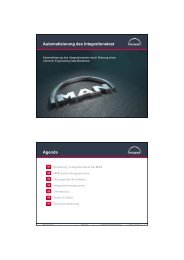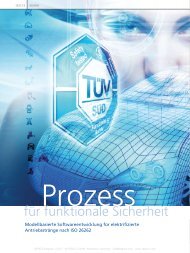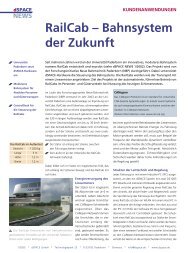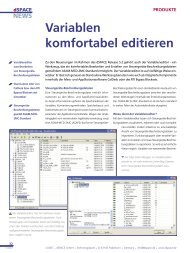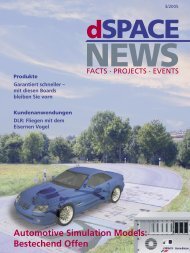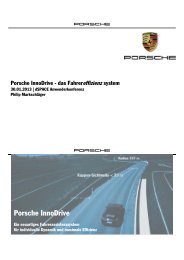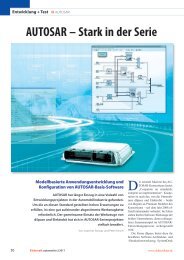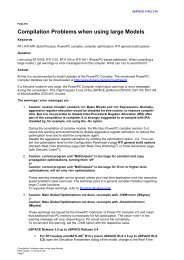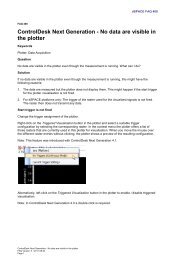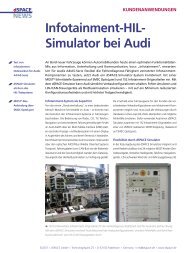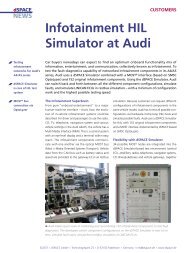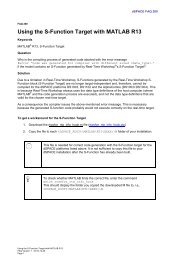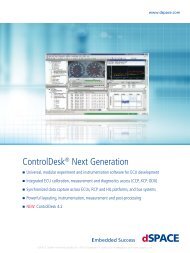magazinE - dSPACE
magazinE - dSPACE
magazinE - dSPACE
Create successful ePaper yourself
Turn your PDF publications into a flip-book with our unique Google optimized e-Paper software.
SAM-F:<br />
pAGe 8 AUTOSAR FUNCTION DeveLOpMeNT<br />
n exterior lights<br />
n interior lighting<br />
n Wipers/washers<br />
n Automatic sunroof<br />
with rain sensor<br />
ARWT (station wagon):<br />
n Automatic rear door<br />
Fig. 1: Comfort functions for the C class (204 series) designed via modeling and automatically generated production code (SAM: central body<br />
computers ARWT: automatic hatch door).<br />
Modelbased design and automatic<br />
production code generation are used<br />
for passenger car development at<br />
Daimler AG. This article describes<br />
the stepbystep method of converting<br />
a modelbased development<br />
process to the AUTOSAR architecture<br />
and reports on experience<br />
gathered so far.<br />
model-Based Development<br />
of Vehicle interior Functions<br />
For some years now, Daimler AG has<br />
used modeling to develop vehicle<br />
functions, especially for com fort and<br />
interior functions. Modelbased<br />
development for the vehicle interior<br />
focuses on the main functions of the<br />
central body computers, each of<br />
which has integrated multiple functions.<br />
Modelbased development<br />
was introduced on a large scale for<br />
the current C class (204 series) (fig. 1).<br />
The modelbased approach is<br />
systematically applied to the series<br />
SAM-R:<br />
n vehicle electrical<br />
system management<br />
n Tailgate lock<br />
n Seat heating<br />
n Seat ventilation<br />
n Rear window heating<br />
n Theft alarm<br />
n Rear window blind<br />
n Trunk cover<br />
currently in production development,<br />
and the number of functions to be<br />
integrated is constantly increasing.<br />
Some of the functions we develop<br />
comprise the entire ECU application<br />
software. Others are what are called<br />
added value functions, i.e., extra<br />
functions added to existing ECUs to<br />
differentiate them from the competition.<br />
In each development cycle, the<br />
supplier is given the function model<br />
that we developed, plus a test<br />
specification, and is responsible for<br />
producing software for the model<br />
and implementing it on the ECU<br />
(fig. 2). Essentially, modelbased<br />
development gives OEMs the following<br />
advantages:<br />
n Early maturity validation by<br />
simulation<br />
n Functions represented and<br />
validated by rapid prototyping<br />
in the vehicle, even before the<br />
ECUs are available<br />
Interior – CAN<br />
1. electronic ignition switch<br />
2. Door eCU front left<br />
3. Door eCU front right<br />
4. Door eCU rear left<br />
5. Door eCU rear right<br />
6. Seat adjustment, driver<br />
7. Seat adjustment, passenger<br />
8. Roof control<br />
9. SAM/SRB front<br />
10. SAM/SRB rear<br />
11. Tire pressure control (USA)<br />
12. Trailer connection unit<br />
13. parktronic system<br />
14. Keyless go<br />
15. Automatic climate control<br />
16. Instrument cluster<br />
17. Multifunction eCU<br />
30. COMAND<br />
37. Weight sensing system (USA)<br />
40. panorama sunroof<br />
Chassis – CAN<br />
1. electronic ignition switch<br />
9. SAM/SRB front<br />
16. Instrument cluster<br />
18. engine electronics (gasoline)<br />
19. engine electronics (diesel)<br />
20. electronic Stability program<br />
21. Steering column jacket module<br />
22. Airbag ARAMIS<br />
23. Reversible belt tensioner front left<br />
24. Reversible belt tensioner front right<br />
41. Adaptive Damping System<br />
vehicle dynamics – CAN<br />
20. electronic Stability program<br />
25. Sensor cluster<br />
Drivetrain – CAN<br />
18. engine electronics (gasoline)<br />
19. engine electronics (diesel)<br />
26. electronic gear shift module<br />
27. Fully integrated transmission control<br />
28. Tank eCU (gasoline)<br />
29. electronic transmission control<br />
LIN – Bus<br />
2. Door eCU front left<br />
3. Door eCU front right<br />
9. SAM/SRB front<br />
10. SAM/SRB rear<br />
18. engine electronics (gasoline)<br />
19. engine electronics (diesel)<br />
21. Steering column jacket module<br />
Telematics – CAN<br />
30. COMAND<br />
33. Central display<br />
34. COMAND Controller<br />
private – Bus<br />
15. Automatic climate control<br />
42. Automatic climate control, rear<br />
MOST – Ring<br />
30. COMAND<br />
31. Sound amplifier<br />
32. Digital radio (DAB)<br />
39. SiRiUS satellite radio (USA)<br />
Diagnostics – CAN<br />
9. SAM/SRB front<br />
38. emergency call system (USA)<br />
Front area – CAN<br />
9. SAM/SRB front<br />
35. Xenon eCU<br />
Headlight master<br />
36. Xenon eCU<br />
Headlight slave<br />
n Direct implementation by<br />
autocoding<br />
n Supplierindependent function<br />
development and further<br />
development<br />
n Reusable functions<br />
n Protection of intellectual property<br />
integration into Software<br />
architecture<br />
At present, when functions are<br />
created via modeling, suppliers still<br />
have a high manual workload when<br />
integrating them into the ECU. The<br />
amount of work involved greatly<br />
depends on the software architecture<br />
used by each supplier, even<br />
when the OEM has specified the<br />
communication part of the basic<br />
software. In some cases, the software<br />
architecture has to be adapted<br />
or specially extended. There is no<br />
completely standardized software<br />
architecture, so sometimes extensive<br />
coordination meetings have to be



